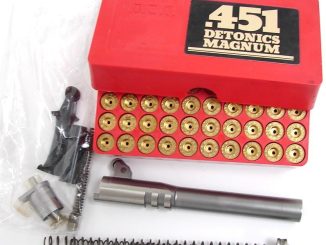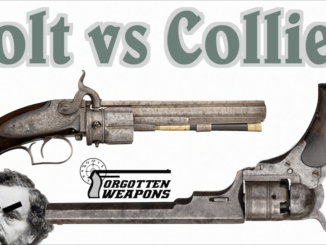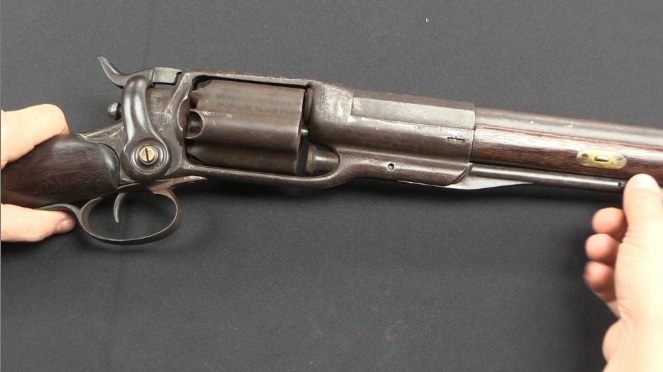One of the options for having multiple shots available in the age of the muzzleloading rifle was the swivel-breech rifle. Such a rifle would have typically two barrels and one lock – one the first barrel was fired, the whole barrel assembly could be rotated 180 degrees to bring the other barrel into alignment with the lock. These could be two rifle barrels, two shotgun barrels, or one of each.
MJ Whitmore of Potsdam, New York build many such swivel-breech rifles and also build some much less common 4-barrel swivel guns. This particular example has two .40 caliber rifled barrels on one side and a combination of a .40 caliber rifle and a .40 smoothbore barrel on the other side. In a particularly neat touch, it holds a single loading rod hidden in a spring-capped chamber in the center of the barrel cluster.




A question;
Why the gun have 4 holes to block the barrels?
Some kind a ”safe” or carrying position?
Best regards
I can see it being a major surprise for any highwaymen, irate Indians or such who would normally assume that the intended victim would have one rifle or shotgun shot prior to possibly reverting to a belt or saddle pistol or two and then reduced to a knife. I have seen 2-barrel swivel breach rifles and shotguns plus 4-barrel ox-harness swivel market hunter shotguns but never a 4-barrel rifle or combination ML weapon. Vary interesting example.
I have read that Timothy Murphy used a double rifle when he shot General Fraser during the Second Battle of Saratoga.
Drat my inability to forget things that were advertised in the back of Shooter’s Bible and Gun Digest in the early 70s, or my ability to forget key details – there was a US company that specialized in underhammer muzzleloading rifles that I can’t remember the name of, but they had a rotating double rifle that was reputed by all three of the muzzle-loader fan gunwriters at the time to be a lot more accurate (as far as being able to put both bullets on the same barn door) as the side-by-side smokepole doubles of the day.
The inescapable problem with double guns, whether muzzle or breach loading, is registry; it is almost impossible to build one where both barrels shoot into the same acceptable area. This is due to many factors with the major being divergency of construction … the barrels are welded together but the bores are not absolutely parallel. Therefore, they shoot at different points of impact at different ranges. About the best one can do is to construct the barrel assembly where the two lines of travel “cross” at a given distance from the muzzle. this is called “registering” the barrels. At both a closed and farther distance they are further appart upon impact. The most interesting feature of this weapon demonstrates one cure for this problem in that with the two riffles in battery it is seen that, like the rotating action you mention, each barrel has its own set of fights and therefore can be sighted in independently so that each barrel acts as if it were a single-barrel rifle. Each MUST be sighted in independently. With the rotating over/under the same applies. The maker of this weapon chose to have one barrel as a small-bore shotgun and used a single centrally positioned rear sight for both barrels while a single for each barrel would have been more practical but would require more work. In this case, the end result, if test fired would probably be that the central sight would be more-or-less accurate for the rifle barrel and “serviceable” for the .40 cal. shotgun which would only be effective at close range anyway. (Probably intended to be used for smaller game.) I have experienced the above with double rifles in both an early Pedersoli Kodiak Express Double .45 muzzleloader as well as those designed for African use. An excellent discussion of the relevance of this supposition is, “Another challenge is the fact that the Pedersoli’s barrels are regulated to a point of aim at seventy-five yards. The company doesn’t state what the powder charge and projectile weight is for that regulation. My guess was that it was a low powder charge of seventy or eighty grains with a patched round ball of 177 grains, or the regulation might be done with lasers with no shooting involved.” found at http://www.chuckhawks.com/africa_muzzleloaders.htm. by Randy Smith. My major personal objection to his decisions is that I much prefer my Dixie Gun Works circa 1960s cartridge primer converters (I bought 20 back then and still have 11 serviceable) instead of ANY percussion caps ever made. Another change I would have suggested is to have a special built barrel set using Green Mountain .45 cal. barrels with a 1:26″ twist with bullets cast using wheel weight material and pressure swaging Teflon into the lube grooves. This bullet has penetrated a 2100# bull through the shoulders and a very large Alaskan Brown Bear by shattering both shoulders for an instant immobilization shot with the bullet mushrooming out to .78 inch diameter and recovered just under the skin on the off side. Personal apologies for the length of the post, but the subject is near-and-dear to an old man’s heart.
A similar problem is convergence for guns on most fighter planes in World War Two. The Hawker Hurricane needed all the guns sighted so that the bullets would strike in a tight group at a preset distance in front. Said distance varied from 300 to 600 yards… Or am I wrong?
You are right except in the case of the P-38 and a few others with the guns mounted in the nose. I am told by a pre-Pearl Harbor Flying Tiger pilot that he could judge his distance from the target by firing a short burst and watching the intersection of the tracers. He was flying a P-40 for the Chinese forces against the Japanese. His name was Richard “Dick” Dagget.
Well, nose mounted guns don’t need much convergence. However, guns mounted in the wings generally have to have a preset convergence point, otherwise they will just pepper a generic area not likely to be occupied by your intended victim. As for the P-40’s case, the tracer convergence is likely a preset distance and his judgement call procedure seems to be a good one. Hopefully nobody loaded his belts entirely with tracer rounds, because those will barely penetrate important spots on enemy aircraft unless the rounds are API-T, in which case the opponent is more likely to be shot through and set on fire while abandoning his mount.
“P-38 and a few others with the guns mounted in the nose”
Most of fighters of VVS RKKA of Great Patriotic War has all guns mounted in fuselage. These guns fire either through propeller arc (synchronous) or through propeller axis (see: https://en.wikipedia.org/wiki/File:Yakovlev_Yak-9_and_Yak-9T_side-view_silhouettes.png )
He did quite well; in fact he recently was chosen to be honored by being adopted by one of the families on Taiwan and given his own shrine in their family. For my help I was made an honorary member of the Chinese Nationalist Royal Marine Corps making me a Chinese Cherokee Double-Marine Redneck. {:>)
A friend of mine (USAF Col., native of Seattle WA, flew with RFC and AEF in WW1 as a teenager, and stayed in USAAC/USAAAF/USAF until retirement in 1960, now gone to Valhalla), had these observations about WW2 fighter MG regulation in the P-51;
1. The RAF normally “harmonized” the 0.303in Brownings in the Hurricanes and Spitfires (up to IXC) to converge on point of aim at 100 yards. Considering that they carried up to eight guns in a Spit or twelve in a Hurricane, this was considered adequate to pretty much dismantle an He-111 in midair with a one-second burst. (800 R/M/gun, eight guns, ~100 rounds delivered, yes, sounds about right.)
2. When they began getting Mustangs with four 0.50in (and he was a transition training officer with the U.S. military mission starting in mid-1940), he had to retrain them to harmonize the guns at 200 yards and fire half-second bursts. Because firing for a full second at 100 yards with the fifties would pretty much detonate a Heinkel right in your face, since about the only thing in one that would stop an 850-grain armor-piercing bullet traveling at 2,850 F/S was… a bomb in the bomb racks.
And since the German bomb racks held the bombs vertically, nose up, like missiles in “Sherwood Forest” in a modern-day boomer, any round into the fuselage had just about a 100% guarantee of introducing itself to Mister SC-500 And Friends amidship, up close and personal.
BTW, this rule also held true for chasing V-1 “buzz bombs”. It had fuselage fuel tanks in back and a one-metric-ton Amatol warhead up front. The blast from that in midair has to be seen to be believed (look on YouTube).
He was aware that some pilots early on “tumbled” the “doodlebugs” by sliding one wing tip under the bombs and raising it slowly. Banking away sharply and slamming your wingtip into the bomb’s wingtip was a myth, and a good way to lose your outer wing, which is not a good thing on a plane without a lot of wing area to begin with.
He never did it, and it was discouraged after a few bombs that landed intact were examined and it was discovered that the fusing system had a side-to-side “upset” switch in it that was intended to set off the warhead if the degree of bank was too great-such as if some fighter pilot did that trick. (Nobody ever said the Luftwaffe was stupid.)
3. Tracers were belted “1 in 5”; every fifth round was a tracer, to help “walk the burst”, and/or let you “hose” short bursts in front of a crossing target so he flew into them.
The lead-computing sight on the Mustang was better than the British sights, but had a habit of burning out its “pipper” illuminator at inopportune moments. Some pilots drew a crosshair on the armored windscreen with a grease pencil, used that, and swore on a stack of Bibles they were using the lead-computer sight the whole time.
The same thing happened with the later LCS on the F-86 Sabre in Korea, as he found out firsthand as an equipment test and evaluation officer at Kimpo in ’51. There, a wad of Wrigley’s PX chewing gum often substituted for the grease pencil marks.
4. Each belt had a solid “block” of five tracer rounds stuck in before the last 20 rounds at the end. When you saw that solid “bar” of red light instead of little “dashes”, you knew you were about “Winchester” on ammo in that particular gun.
5. On the P-51D with six fifties, most pilots had a cutout switch installed to cut the outboard gun on each wing out of the firing circuit. The two inboard guns on each side had 250 rounds apiece, the outboard had only 125. To fire the two outboard guns, you just flipped the cutoff switch back the other way to link them into the firing circuit.
Generally, four guns with a total of 1000 rounds of half-inch mayhem was considered adequate for most missions, and thus you had 250 rounds handy in case you got bounced on the way home, or just saw a ground target that was too good to pass up.
He had 26 confirmed kills from 1916 to 1952 (including a Zeppelin, a Gotha G.V, an Me-262, and 3 Mig-15s), plus about a dozen probables, and only had to “walk home” twice (once in ’18, once in ’45), so I figure he probably knew what he was doing.
cheers
eon
As your friend was in the USAAC/USAAF during WW2, he seems to have gotten some details wrong about RAF fighters:
1. 100 yards harmonization was indeed favored by experienced pilots for the .303 caliber “peashooters” the early Hurricanes and Spitfires (as well as Gladiators) had to make do with. Longer ranges up to 300 yards was often used by novice pilots, who didn’t have the necessary skill to hit at such close ranges. 100 yards is a very short distance in air combat. Still, the Heinkel He-111 and Junkers Ju-88 were quite difficult to shoot down with the .303 machine guns and frequently survived hundreds of hits to non-critical areas, which is why the RAF switched to 20mm autocannon (Hurricane IIc onward) or mixed MG/AC (Spitfire from Vb to XVIII) armament as soon as possible. Four 20mm cannons firing a mixture of AP and HE ammunition really could “dismantle” most WW2 twin-engine medium bombers pretty quickly. The .303 machine guns (two per wing) in Spitfire Vb to IX were kept only because there was no room for bigger guns in the thin wings of the Spitfire prior to the E wing designed for the XII; their actual effect on later bombers and even fighters with armor and self-sealing fuel tanks was pretty minimal.
2. I seriously doubt .50″ inch bullets would detonate amatol or TNT high explosive bomb fillings in any kind of reliable way even with incendiary. Certainly the impact only will not detonate those high explosives. Incendiary might, since it burns very hot, but only if it came with direct contact with the HE. 20mm HE shells are a different matter, but often they detonated before reaching the HE filling of internally carried bombs as well (bombs on external racks are more exposed and could be detonated especially by APHE ammunition).
Typically aircraft mid-air explosions were caused by fuel explosions from leaking fuel tanks. The leaking gasoline, with some luck, will form a volatile mixture with air, which can then be ignited by burning incendiary or autocannon HE ammunition explosion. .50″ API was able to poke holes to the fuel tanks much more effectively than .303″, especially if the fuel tanks were self-sealing. A .5″ hole is a much more difficult to seal by rubber liners than a .311 hole.
The He 111 was the only German bomber to have a vertical bomb bays and the largest bombs it could carry were 250 kg (SC-250).
The V-1 missiles were mostly intercepted by Hawker Tempest fighters with a uniform 4x20mm autocannon armament. The Tempest had a better low altitude performance the the Spitfire XIV or P-51D Mustang. Later also Meteor jet fighters were used.
3. The lead-computing Mark II Gyro Sight was a British invention, produced under license in the US by Sperry as the K-14. It was definitely superior to all earlier non-computing reflector sights. Most British fighters were equipped with one from Spring 1944 onward. US sources sometimes confuse the Mark II G.G.S. with the older reflector-only Mark II or IIL (the former was a development of the latter, so the British did not bother to change the Mark), which was generally not as good as the best US (non-computing) reflector sights like the N-9.
Love your long, informative, and entertaining replies and comments, Bill! Know about the difficulties of “regulating” a side-by-side double to a common point of aim – a friend 40 or so years ago had an Italian (I think) double pistol that was major cool points among our bunch of rural teen gun nerds – .44 caliber, 10 or 12 inch barrels, outside hammers of course, think he had paid all of a hundred bucks for it new. But once you figured out where to aim it so that one barrel would hit the proverbial barn door the other barrel to the same point of aim would wind up in the back 40 if not the next county. Thought that was the point of the over-and-under doublebarrel swivel I mentioned above – that with separate sights for each barrel it was possible to have a fairly accurate second shot.
A beautiful and clever piece of work. I wonder if it was made to order by someone.
“4-barrel”
In Germany, where combination guns are popular, 4-barrel guns are called Vierling. Each combination gun can be called depending on number of barrels:
3 barrels – Drilling
4 barrels – Vierling
5 barrels – Funfling
also special names for some subset of mentioned guns exist – Bockdrilling has 2 barrels over-under and 1 lateral, when Schienendrilling has 2 barrels side-by-side and one above in center (if it is not clear, please google:image:Bockdrilling and google:image:Schienendrilling)
Here you can see: http://www.hoferwaffen.com/hofer_52.php?lang=en examples of how barrels can be arranged
This table: http://www.wildhueter-st-hubertus.de/html/waffentechnik_02.html should help to understand
A fine old piece of gunsmithing. I can imagine a carbine version for a VERY elite dragoon regiment. Well heck, I can imagine a modern replica, fully functional, for a very well-heeled black powder addict.